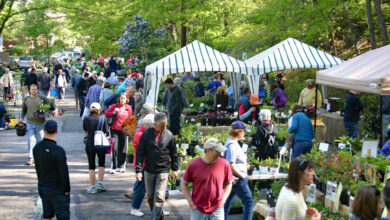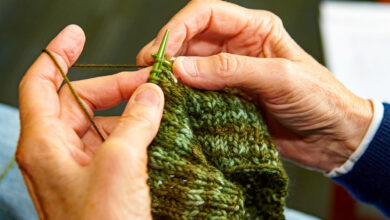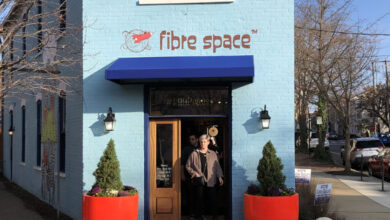Keeping Tradition Alive at the Old Town Farmers Market
By Kris Gilbertson
It’s common lore in Alexandria that the Saturday morning farmers market on Market Square is the oldest farmers market in the U.S. continuously held at the same site, and dates from 1751. Less well known is the robust and diverse roles, on open ground and in buildings, that Market Square (the city block bordered by Royal, King, Cameron, and Fairfax Streets) played as the heart of Alexandria, which is what the planners intended.
The square has been a meeting place for assemblies called by the town crier, and a marshaling area for militia and later for professional soldiers. It has been the site of the county seat, a school, a jail (including stocks and pillory), a museum, an open-air horse market, numerous small businesses, the Alexandria Gazette, and one of George Washington’s favorite taverns. Just to name a few. But through all the uses and changes over 264 years, the one constant has been the farmers market.
The market has maintained in part because families of vendors have adapted to changing conditions and just kept showing up. This is the story of one of those families, the Doves, who sell flowers ten months a year on Market Square and have done so for generations.
A Family Tradition
Senior family members today are Mrs. Doris Dove Cassedy and her brother Lenard (Lenny) Dove. Doris and Lenard are helped at market by Doris’s youngest daughter Stacey (Missy) Petitt, and grandsons Robbie and Charlie Petitt. In all, 21 family members—aunts, uncles, brothers, sisters, cousins—have sold at the Old Town market. But the first Dove on scene was Doris and Lenny’s great-grandfather, Will Kitson, in the late 1800s.
The family used to own 35 acres on upper Van Dorn Street (then called Oakwood Road) in Franconia. Will Kitson and his daughter Norma (Nanny) Talbert raised vegetables, flowers, and chickens, and made butter and crafts that they took to market by horse and buggy. Later, Nanny and her niece Virginia continued to sell flowers, foods, and crafts. Nanny bought a Ford Model A, although she never had a license, so that Virginia could drive them to market with their goods. Virginia married Vernon Dove in 1932. They had ten children, of whom Doris is second oldest and Lenny the youngest.
The Market Square of Old
Before 1960, Market Square, including City Hall, was far different from today. City Hall was a U-shaped building dating from 1871. It faced Cameron Street, with wings stretching a half block south on Royal and Fairfax, creating a 3-sided courtyard. The market took place in the courtyard, under open sheds that gave shelter from the sun, but not heat or cold. During the coldest weather, vendors moved into the Royal Street wing of City Hall.
The plaza didn’t exist. Sharpshin Alley, some 20 feet wide, ran mid-block from Royal to Fairfax. Market Alley ran from King to Sharpshin, again at mid-block, dividing the plaza area into two quarter blocks. Both were in commercial use until the 1965 Plaza project.
The project was a response to general urban decline suffered nationwide during the 1950s. In 1961, the city began to revitalize the area by renovating City Hall to build office space and court chambers in the courtyard. Chauncey’s Grocery, a business on the plaza area, had gone out of business; the market moved into its empty building.
When they finished City Hall, work began on the plaza and underground parking garage. All the small buildings in that section of the Market Square were razed. Vendors were first moved inside the new City Hall, but then were put out onto Cameron Street.
The market did poorly on Cameron Street. Many very long-time vendors quit. By the time the plaza was finished in 1967, only eight or nine, including Doves Flower Stand, were left. City government debated closing the market, but those eight or nine vendors and many city residents strongly resisted that plan. Support for the market was bolstered by assertive townswomen and a claim (untested) that the original deed gave the land only for a town market and, if the market closed, it would revert to the trustees’ heirs.
Eugene Barnwell, Director of General Services then, stated, “Cameron Street doesn’t lend itself to a good market. If the city doesn’t encourage it or make a place for it, it could well die out. It would be a shame to lose it because it’s a vestige of Alexandria’s former days.” And so the market moved one more time, to Market Square.
Building the Beltway
During reconstruction of Market Square, another significant building project took place—I-495, the Beltway. To build through Franconia, the state claimed 11 acres of the Dove family property. “We had a family cemetery there and they just destroyed it,” says Doris, “took some of the bodies, what they could find, and put them in different cemeteries.”
The land was not taken easily. When protest failed, Doris’s grandmother Elsie McGuin, shotgun in hand, faced off with the bulldozers saying she wouldn’t have the graves disturbed. “She stopped ‘em,” says Doris, “until….” The Virginia Supreme Court ruled that the cemetery could not stop construction as long as the state paid to move the bodies. And many more bodies, including the graves of slaves and Confederate soldiers, were unearthed during road construction.
Did family have a say in where the bodies went? “Nobody had a say but Judge Brown,” says Doris. “Thank God he had a heart attack.” For the 11 acres taken, the family received $1,100.
“Rain, snow, blow – it’s outside!”
The market operates 52 weeks a year. Some vendors come every week, but the Doves take a break in January and February. “It’s just too cold,” says Doris. But weather is not the only challenge.
In recent years, the requirement to grow or make whatever you sold went away. “We’re getting too many people bringing in the same thing,” says Doris Cassedy. “Now they’re just buying everything. Before you had to raise your stuff; you couldn’t just open a stand like they do now.”
Todd Healy, artist and owner of Gallery Lafayette and long-time market vendor, noted that the proliferation of farmers markets in the area has dispersed the customer base. Where each town used to have just one, most now have several to choose from.
“They wanted more vendors in the [Old Town] market,” says Lenard Dove. “There’s no way in the world you can work a farm and go ahead and do these farmers markets two or three days a week. It takes all the time you’ve got to do your own work all week long, one week to the next.”
Market hours have also fluctuated, from true farmers hours of 5:00 to 9:00 through various time slots to the current 7:00 to 12:00. The Doves depend on loyal customers they’ve had for 30, 40, even 50 years, who tend to come early, so they get there by 4:00 a.m.
Festivals and shows staged on the square often cut into market time. The plaza is sometimes so crowded there’s hardly room to move, which causes parking conflicts, too. Vendors have permits now, but they used to feed meters like everyone else.
“I remember being the runner,” says Missy. “When the fountain comes on, it’s 8:00 a.m. And 8:00 a.m. is when the meters start. I would hear them yell for me and then I’m going across the square gathering a whole bunch of quarters for whoever needed quarters in their meters, so no one would get a ticket. There were some meter maids down there at 8 o’clock just to be mean, knowing we were there selling, and that we might not get to the vehicle in time. So I’d run along and put one quarter in each, then go back and fill up however many were needed. And then do it again.”
Vendors prefer parking on the Royal Street side where there are no steps. The Doves park on Fairfax Street. “After they built the City Hall with the jail, there was a cut in the curb and they used to back the paddy wagons in there to take them to court on Saturday mornings, while the market was going on,” say Lenny. “When Mrs. Lawson* was in there, she gave permission for us to do it.”
“And Lenny’s truck was perfect!” says Missy. “You could back up to the steps, flip the tailgate down, and walk right out on the top step.”
“Vola Lawson was very nice and friendly,” says Doris. “Also Patsy Ticer. Jim Moran was always very good to us, a real gentleman. We did flowers for his first wedding.”
“That’s one of my earlier memories,” says Missy. “Mrs. Lawson would come into market and get her things, and she’d give me $2 to take them down to her car. She always left her car unlocked and she was always in the first spot in the parking garage.”
Spotsylvania
Doris and Lenard’s mother, Virginia, died in 2000. With ten heirs, keeping the Van Dorn Street property wasn’t feasible, so they sold it.
Doris, Missy and her sons moved to 27 acres in Spotsylvania where they grow the field flowers for which they’re known: yarrow, zinnias, cox comb, sunflowers, Russian sage and wildly popular tuberoses (coming in late July and August!). All the work is done by hand. Lenny buys flowers they can’t grow from wholesalers in the District and Newington and takes them to the farm, where he and Doris do the arranging themselves. Doris also sews quilts to sell.
Doris was born in Franconia. Of the family’s houses, only the one where Lenny lived with their mother Virginia had running water. Doris and her family went up to Virginia’s house to use facilities. Doris didn’t have running water until the move to Spotsylvania in 2000. She was 65. This family can’t see the attraction of camping.
“But I’ll tell you one thing,” says Doris, “you can still live and be happy if you don’t have all that. It’s how you were raised up.”
Customers of Dove’s Flower Stand
Some people have bought the Doves’ flowers for so long that even when Doris and Lenny don’t know their names, they do know what will be ordered. “The customer walks up and these two just look and say, ‘Oh you want your 25 wreaths and your six bunches of this and that,’ and they remember these orders. And I don’t know how they do it,” says Missy. Do they keep a log? “Nope,” says Doris, “we just know it.”
A representative of Reebok once brought them 50 high-top tennis shoes to make fresh flower centerpieces for a conference. A woman years ago ordered dried flowers for The White House. One gentleman comes in every other week and buys four mixed bunches of flowers. His name is Mr. Ritz, and “he’s a really neat guy.”
“We have people come back that we did weddings for 30 years ago, and they’re still our customers,” says Doris. During the 1980s and 90s, she arranged flowers for as many as 60 weddings a year. Now, “it’s down to four or five,” says Doris, “but at one recent Old Town wedding, the bride’s mother was pregnant with her when she first came into the market.
At the Christmas season, the Doves create 40 Kissing Balls for the city, with 400 lights in each, to be strung on lamp posts around market square. They also make boxwood Christmas trees—“little trees for little homes”—a nice way to wrap up their season.
Looking ahead
In 2014, Doris Cassedy was diagnosed with her second occurrence of cancer. She was gone for a few weeks for treatment, during which word spread. Customers sent more than 40 cards in two weeks, many including stories of how the Doves’ flowers had raised their spirits. One message arrived on a delicate handmade card and read in part:
My daughter made this when she was about eight years old. It has been in my “special” drawer for the past thirty-seven years…just being saved for a very special person.
From another:
In 1980, my husband of 13 years left me and took our joint bank account with him…It was a very sad and difficult time for me, but somehow I managed to scrape together the $1 or $1.50 for a bouquet…Your flowers have kept me going for nearly 35 years now, along with your cheery Saturday “hellos”…When my current husband and I were married twenty some years ago—your flowers were there!
“If my mom couldn’t go to the market,” says Missy, “I know that would be it. As long as she can go, she’ll be fine.”










